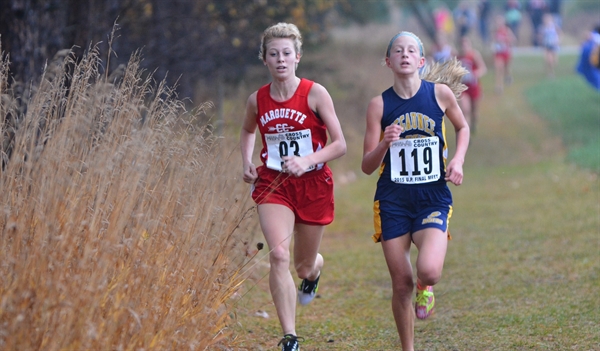
UP Champs Repeat as Rudden Takes 1st
By
John Vrancic
Special for MHSAA.com
October 24, 2015
FLAT ROCK — Marquette High School’s Lindsey Rudden has excelled in track and cross country throughout her prep career.
The senior harrier has earned her share of Upper Peninsula Division 1 titles in track, but hadn’t won at the U.P. Cross Country Finals prior to Saturday.
 That all changed on a cloudy, rainy and breezy day at Beauchamp’s Grove as she captured her first MHSAA cross country championship, covering the 3.1-mile course in 18 minutes, 59.8 seconds.
That all changed on a cloudy, rainy and breezy day at Beauchamp’s Grove as she captured her first MHSAA cross country championship, covering the 3.1-mile course in 18 minutes, 59.8 seconds.
She was followed by Negaunee sophomore Clara Johnson (19:05.8), Westwood senior Katie Etelamaki (19:09.6), Sault Ste. Marie sophomore Mackenzie Kalchik (19:21.6) and Marquette senior Holly Blowers (19:27.4).
“It’s overdue,” said Rudden, who plans to run at Michigan State University next fall. “The second mile was real fast. We were pushing each other. It’s pretty humid, which made it hard to breathe. The course was pretty muddy in the first mile; otherwise it was pretty solid.”
The Marquette girls the team title won for the third consecutive year, edging Sault Ste. Marie 40-49. Negaunee placed third with 97 points, followed by Calumet 115 and Houghton 131.
“All the girls ran well in tough conditions,” said Marquette coach Dale Phillips. “I’m happy for Lindsey. This definitely takes a weight off her shoulders. This is a nice addition to her resume. Holly ran a nice race and I think Becci (McNamee) had a personal best. Our fifth and sixth girls (Chloe Henning and Samantha Borzick) also ran their personal bests, which was a big help.”
Johnson’s strategy was to stay with Rudden as long as she could.
“She (Rudden) is really good,” said Johnson. “I hung with her for nearly two miles. I didn’t have enough to stay with her all the way, but I thought it was worth a try. I thought Katie (Etelamaki) also ran real well. I’m glad I got to race with her all year. She was really closing the gap in the end.”
Kalchik ran a personal-best time, helping her move up a place from last year’s Finals.
“I didn’t want to go out too fast,” said Kalchik, who got sick after two miles. “I felt pretty rough, but just pushed through it. The girl from Marquette (Blowers) was coming up on me. It was hard. I felt good coming in here, knowing the competition. I had a better idea what to expect.”
This also marked a personal best for Blowers, who had hoped to break 19 minutes.
“This is not what I was hoping for, but we were working as a team,” she said. “I wanted to do it for the team. We have great girls on our team and great competition. I’m going to miss this so much.”
Sault Ste. Marie’s Megan Arbic placed sixth (19:32.2) and teammate Courtney Arbic took eighth (19:45.9).
“It went great,” said Sault coach Jim Martin. “Our top five girls ran lifetime bests by 20-30 seconds. They just went out and ran like they wanted to be on the podium. I’m real happy for them.”
Gladstone junior Leigha Woelffer, who was crowned champion a year ago, took 10th this time (20:19.8). Etelamaki also was seeking her second individual title after winning the Division 2 race in 2014.
Division 2
Ishpeming was a repeat champion with 31 points. The Hematites were followed by Hancock at 49, Gogebic at 83, St. Ignace at 89 and Norway with 118 points.
 “I’m pleased to see our boys and girls both win,” said Ishpeming coach P.J. Pruett. “This is only the fourth time the Ishpeming girls were U.P. champions. It happened in 1979 and ‘80 and now last year and this year, and our boys were pretty dominant.”
“I’m pleased to see our boys and girls both win,” said Ishpeming coach P.J. Pruett. “This is only the fourth time the Ishpeming girls were U.P. champions. It happened in 1979 and ‘80 and now last year and this year, and our boys were pretty dominant.”
Ishpeming junior Khora Swanson earned top individual honors at 20:56.2, followed by Hancock’s Taylor Pertile (21:15.2), teammate Mariah Bertucci (21:44), Gogebic’s Melissa Wanink (21:45.4) and Hancock’s Madisyn Wright (21:46.4).
“I’m pleased with my time,” said Swanson. “I just worked hard today. We had to get our points by catching people in front of us. I’m just happy we won as a team.”
Division 3
Chassell edged Munising 67-69 for its second straight Division crown, followed by Cedarville at 92, Dollar Bay at 105 and Brimley at 114.
“Sticking to the basics and believing in themselves were the keys to our victory,” said Chassell coach Marco Guidotti. “They were up to the challenge. They really like competing in the West-PAC (West Peninsula Athletic Conference). Competition in our conference is strong year in and year out.”
 Newberry senior Natalie Beaulieu won the Final for the second straight time in a school-record 19:24.5. She was followed by Chassell senior Shitaye Sam (19:46.6), Munising sophomore Alyssa Webber (19:57.4), Cedarville’s Emma Bohn (20:55.7) and Brimley’s Lauren Halvorsen (21:30).
Newberry senior Natalie Beaulieu won the Final for the second straight time in a school-record 19:24.5. She was followed by Chassell senior Shitaye Sam (19:46.6), Munising sophomore Alyssa Webber (19:57.4), Cedarville’s Emma Bohn (20:55.7) and Brimley’s Lauren Halvorsen (21:30).
“I made my move at the mile mark and started to get some separation,” said Beaulieu, who ran the first mile in 5:51. “I was a little concerned at first because I thought I may have gone out too fast. But I knew where I needed to go, and the hills were then my only concern. I just tried to stay in my pace.”
The MHSAA Cross Country Finals are sponsored by the Michigan National Guard.
PHOTOS: (Top) Marquette’s Lindsey Rudden (left) runs stride for stride with Negaunee’s Clara Johnson before breaking away for the Division 1 championship. (Middle) Ishpeming’s Khora Swanson sprints the stretch in first place in leading the Hematites to their second straight title. (Below) Newberry’s Natalie Beaulieu won her second straight individual title in Division 3, while Chassell’s Shitaye Sam led her team to its second straight team championship. (Photos by Cara Kamps.)

MHSAA Vault: MIS Rose to Challenges to Host 2020 LP Finals
By
Rob Kaminski
MHSAA benchmarks editor
November 12, 2021
The “MHSAA Vault” features stories from past publications and other documents in the MHSAA Library. This issue takes a look at the MHSAA Cross Country Finals at Michigan International Speedway, which celebrated 25 years in 2020 – although it was an event that nearly didn’t happen last fall …
In 1996, the MHSAA and Michigan International Speedway began a partnership the changed the course of the Lower Peninsula Cross Country Finals – quite literally.
The land in and around the track at Brooklyn would host the Finals for all classes of runners in one place on one day, an annual festival of nearly 2,000 runners competing for the MHSAA’s top honors.
Even skeptics – and there were several among running purists who thought the course was too flat, for example – can’t deny the results.
Finals attendance nearly doubled in that first year, and crowds in excess of 10,000 have enjoyed a day of racing several times, including a record 12,153 in 2011.
Enthusiastic crowds were the norm in recent years, with 11,232 in 2017, and nearly 11,000 in 2018 (10,989) and 2019 (10,873).
In fact, attendance failed to reach at least 8,000 only twice since the move to MIS.
Of course, last year was an exception, when attendance was limited to 1,000 spectators per session due to the COVID-19 Pandemic. Fans also were restricted to the grandstands rather than following the action throughout locations on the course.
To reduce the number of runners in each race, the event was spread over two days, with each Division being run in two separate “sections” with times then combined at the end to determine team and individual champions.
While not ideal, the end result was another year of fantastic efforts at MIS – both from student-athletes and those behind the scenes.
“Even at the last hour, less than a week ahead of the Finals, we were closer to not having the Finals than we were to having them,” said MHSAA Assistant Director Cody Inglis, who coordinates the cross country postseason. “Rumors and challenges of mandated shutdowns, testing and other requirements were being discussed and caused a lot of unknowns. Even at the Regional level, we had schools, Regional courses and hosts shutting down their facilities; we had to relocate four Regionals 48 hours prior to race times. That scenario just could not happen at the Finals level where far more runners and much more travel would be involved.”
Among the many last-minute hurdles was the edict from NASCAR – which owns MIS – that all persons on site be temperature checked upon entry. That meant securing thermometers that were easy to operate in short order, along with personnel necessary to conduct the readings.
The attendance limitations certainly helped to implement the temperature screening, but brought their own issues.
“Limiting spectators was not a popular decision, but it really was the only way to have a race,” Inglis said. “We were taking direction and working with policies and protocols from the MDHHS, the Governor’s office, Lenawee County Health Department, MIS and NASCAR.”
Part of the solution was to utilize the grandstands as a “barrier” between participants and spectators. The reduced number of fans were dispersed over thousands of seats while still allowing them the chance to watch their student-athletes compete.
“It wasn’t the same, it wasn’t easy or perfect, but it was what we had to do to have a race,” Inglis said. “Separating the Finals into two days and different sections also allowed us to spread out the event and limit the number of people on site at any one time. This was a key part of the plan and worked well even though it separated races within a Division.”
The MHSAA, MIS and the cross country community never lost focus of the main goal: a culmination of the season for the student-athletes, who deserved something last year more than ever. And, more than ever, MIS once again displayed its advantage as a venue that could adapt to the fluid nature of the times to pull off the event.
“There were some thoughts of using four different sites, but as we learned during the Regionals, the climate of things was so tenuous from one area of the state to another that we couldn’t be 100-percent certain that there wouldn’t again be last-minute cancelations,” Inglis said. “MIS was wonderful to work and collaborate with, and was the best option to get it done. It was never mentioned once publicly about the possibility of not having the Finals – only how we could best do it under uncharted conditions.”
The moving parts and ever-changing scenarios created more complexity than ever in finalizing a season, but every decision was made with the complete desire to conduct the Finals as close to normal as possible.
“I firmly believe that a finish to the season, no matter the differences in race formatting and fan experience, was something everyone would have taken when the season began in August,” Inglis said.
Indeed, the finish line in Year 25 at MIS might have been the most gratifying of them all.

